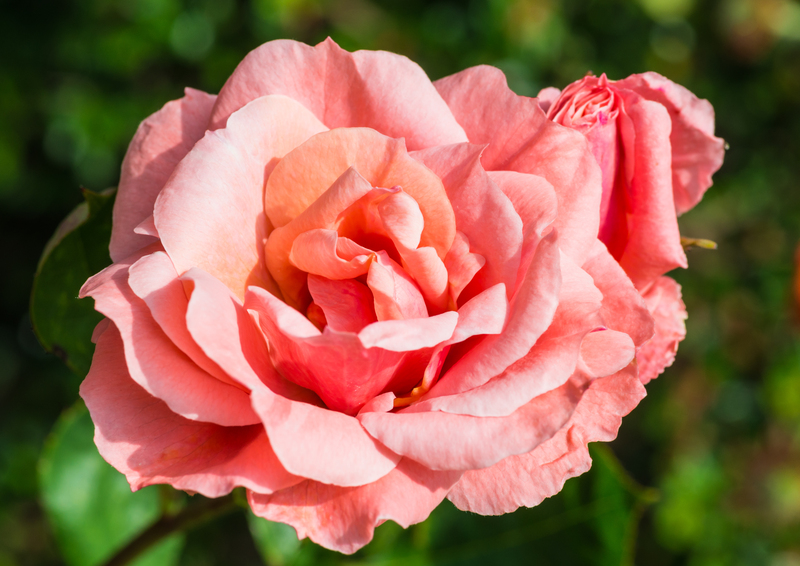Peace and Tranquility: The Art of Zen Garden Design
Posted on 17/09/2025
Peace and Tranquility: The Art of Zen Garden Design
The modern world is increasingly fast-paced and chaotic, making the desire for peace and serenity stronger than ever. Zen gardens--originating in ancient Japan--have long stood as sanctuaries of tranquility, offering both visual harmony and a space for meditative calm. Whether you seek a small retreat in your backyard or an inspired focal point for your landscape, understanding the art of Zen garden design will help transform your environment into an oasis of mindfulness and beauty.
What Is a Zen Garden?
Zen gardens, also known as karesansui or dry landscape gardens, are meticulously designed spaces that reflect the essence of peace and tranquility. Rather than relying on lush vegetation or colorful blooms, the
These gardens originated from Buddhist temples in Japan during the Muromachi period (1336-1573), serving as places for meditation and spiritual reflection. Over the centuries, Zen gardens have come to embody the concept of simplicity and inner calm, blending natural elements in a way that inspires mindfulness and contemplation.

The Philosophy Behind Zen Garden Design
At the heart of Zen garden landscaping lies the philosophy of Zen Buddhism, which values simplicity, harmony, and the dismissal of clutter. The intentional arrangement of elements is designed to lead the mind toward peace, tranquility, and balance.
- Simplicity (Kanso): Fostered by using only what is essential, reflecting the beauty of restraint.
- Naturalness (Shizen): Elements should appear to be untouched by human hands, arranged as nature intended.
- Asymmetry (Fukinsei): Avoidance of perfect symmetry to recreate the imperfection found in the natural world.
- Tranquility (Seijaku): The ultimate goal--that of inner quiet, achieved through graceful design.
A Zen garden is much more than an aesthetic landscape; it's an invitation to pause and experience a moment of profound inner peace.
Essential Elements of a Zen Garden
1. Rocks and Stones
Rocks represent permanence and the mountain landscapes of Japan. Varying in shape and size, they are often used to symbolize islands, peaks, or animals. The placement and selection of stones is deliberate--each stone tells a story and adds to the garden's sense of age and endurance.
2. Sand and Gravel
Sand or fine gravel substitutes for water, streams, or seas. These materials are raked into patterns, such as waves or ripples, which evoke flowing water and invite contemplation. Raking the sand becomes a meditative act, reinforcing the connection between the garden and the practitioner.
3. Moss and Minimal Plantings
While vegetation is limited in traditional Zen gardens, moss is a favored plant for its quiet beauty and ability to add a sense of timelessness. Other restrained plantings might include evergreen shrubs or small trees, always chosen for their subtlety.
4. Bridges, Lanterns, and Ornaments
Although not always present, stone lanterns and small bridges may be included for added interest, symbolizing guidance or the transition from one world to another. Ornaments must blend seamlessly and serve the garden's harmonious spirit.
Design Principles for Peaceful Zen Gardens
To craft a Zen-inspired garden that offers true tranquility, it's important to consider the underlying design principles that guide arrangement and selection.
- Balance Through Asymmetry: Resist the urge for perfect symmetry. Allow each element to interact organically, with empty spaces (ma) offering as much interest as solid forms.
- Subtle Color Palette: Natural hues dominate--a range of greens, grays, and earth tones unify the garden and avoid visual overstimulation.
- Orientation and Flow: Pathways and sightlines guide the eye and the visitor subtly through the space, revealing new perspectives with each step.
- Layering and Depth: By carefully arranging rocks and plants, a sense of depth can be created, making even small gardens feel expansive.
Step-by-Step Guide: How To Create Your Own Zen Garden
Designing your own Zen refuge doesn't require vast spaces or unlimited resources. You can adapt the art of Zen garden design to a corner of your backyard, a small patio, or even an indoor area. Here's a step-by-step process for crafting your tranquil retreat:
Step 1: Choose The Location
Select an area that's quiet and away from heavy foot traffic. Zen gardens thrive where they can be appreciated in silence, ideally near an area where you can sit and meditate or reflect.
Step 2: Plan the Layout
Sketch a basic outline of your garden. Visualize where you'll place rocks, sand, and plants. Remember, asymmetry and negative space are crucial for an authentic feel.
- Decide what each element will symbolize--for example, use rocks for mountains or gravel to represent water.
- Plan for empty spaces to highlight the elements you do include.
Step 3: Prepare the Ground
Remove all grass, weeds, and debris. Lay down a weed barrier to make upkeep easier and ensure a neat, tidy appearance. Frame your garden with wood or stone borders to define the space.
Step 4: Place The Rocks and Stones
Begin with the largest stones, orienting them in groupings of odd numbers (often three or five), as this is more harmonious and natural. Partially bury the stones to make them appear as though they have always existed in that spot.
Step 5: Spread Sand or Gravel
Fill the bulk of your garden area with raked sand or gravel. Use a rake to create flowing patterns--try gentle, sweeping lines to signify water moving around rocks. This act of raking can become a mindful meditation in itself.
Step 6: Incorporate Optional Plants and Ornaments
Add moss around stones for softness, or plant a few low-growing evergreens. If choosing ornaments like lanterns or basins, ensure they blend subtly into the scenery.
Step 7: Enjoy and Maintain
A Zen garden's peaceful beauty depends on regular upkeep. Remove leaves, re-rake patterns, prune any vegetation, and take the opportunity to enjoy stillness during your visits.
Benefits of Zen Garden Spaces
Integrating the zen garden concept into your landscape offers powerful benefits for both the mind and the senses:
- Reduces Stress: The act of creating, maintaining, and even gazing at a Zen garden centers the mind and promotes relaxation.
- Enhances Mindfulness: Every visit can become a moment to breathe deeply, reflect, and enjoy the sensation of being present.
- Improves Focus: The minimalistic design lowers distractions, making these spaces ideal for meditation or quiet study.
- Beautiful All Year: Since Zen gardens rely on rocks, moss, and evergreens, they maintain their beauty year-round with relatively low upkeep.
Common Zen Garden Mistakes to Avoid
While designing your own oasis, keep in mind these common pitfalls that can detract from tranquility and harmony:
- Overcrowding: The aim is simplicity. Too many rocks, plants, or decor can clutter the space and overwhelm the senses.
- Ignoring Scale: Choose elements that suit the size of your garden; oversized rocks or out-of-place structures can throw off the entire composition.
- Neglecting Negative Space: Embrace emptiness as a feature, giving each element in the garden room to "breathe" and be appreciated in isolation.
- Using Unnatural Materials: Traditional Zen garden design calls for organic, earthy materials. Avoid synthetic substitutes.
Enhancing Zen Gardens with Modern Touches
While classical Zen gardens follow ancient guidelines, modern Zen landscaping allows for new interpretations. Consider these ideas for a contemporary twist:
- Integrated Water Features: A subtle bubbling fountain or small pond can add a gentle, soothing sound to the garden.
- Lighting: Low-voltage landscape lights or lanterns can introduce a magical glow in the evening while maintaining peace and serenity.
- Sculptural Elements: Choose minimalist, abstract sculptures that echo the intent of the garden.
- Indoor Zen Gardens: Create small tabletop versions utilizing sand, stones, and tiny rakes for office or home meditation spaces.
The Role of Zen Gardens in Today's World
With the ongoing demands of modern life, the peace and tranquility of Zen gardens become ever more valuable. Incorporating the art of Zen garden design into urban, suburban, or even digital spaces is a testimony to the enduring power of minimalism and mindfulness.
In public parks, temples, homes, and workplaces, these gardens provide areas of respite and reflection--a reminder that amidst chaos, calm can always be cultivated. They foster a sense of connection with nature, self, and the flow of life.
Famous Zen Gardens Around the World
For inspiration, consider these renowned examples of the art of Zen garden design:
- Ryoan-ji (Kyoto, Japan): Perhaps the most famous Zen garden in the world, known for its mysterious arrangement of fifteen stones set amidst white gravel.
- Daisen-in (Kyoto, Japan): A masterful dry garden, representing rivers, waterfalls, and even the journey of life in stone, sand, and delicate plantings.
- Portland Japanese Garden (Oregon, USA): A modern interpretation of Zen design principles, featuring winding paths, exquisite stonework, and quiet corners for reflection.

Frequently Asked Questions About Zen Gardens
Can I build a Zen garden in a small space?
Absolutely; even a balcony, patio, or tabletop can accommodate a minimalist Zen garden. Focus on fewer elements, negative space, and careful placement.
Do Zen gardens require a lot of maintenance?
Compared to traditional gardens, Zen gardens are low-maintenance but require regular raking, debris removal, and occasional pruning for optimal visual calm.
Can I incorporate flowers in my Zen garden?
Although classical Zen gardens rely on understated foliage, you can include a single blooming plant or subtle ground cover--just ensure it doesn't overwhelm the peace and simplicity.
Is there a spiritual practice associated with Zen gardens?
Yes, tending to a Zen garden--especially raking the sand or gravel--can be a form of moving meditation, fostering mindfulness, groundedness, and a deeper experience of peace.
Conclusion: Creating Your Sanctuary of Peace and Tranquility
Embracing the art of Zen garden design is about far more than landscaping; it is a lifestyle choice, an expression of a mindful approach to the everyday. By blending natural elements, space, and thoughtful design, you can create a retreat that serves as a daily reminder to slow down, breathe deeply, and reconnect with inner stillness.
Whether you aspire to build a classic dry landscape garden or a modern, Zen-inspired nook, peace and tranquility are always within reach. Let your garden be a sanctuary--a living work of art--inviting you to practice the mindful art of being present, one serene stone at a time.



